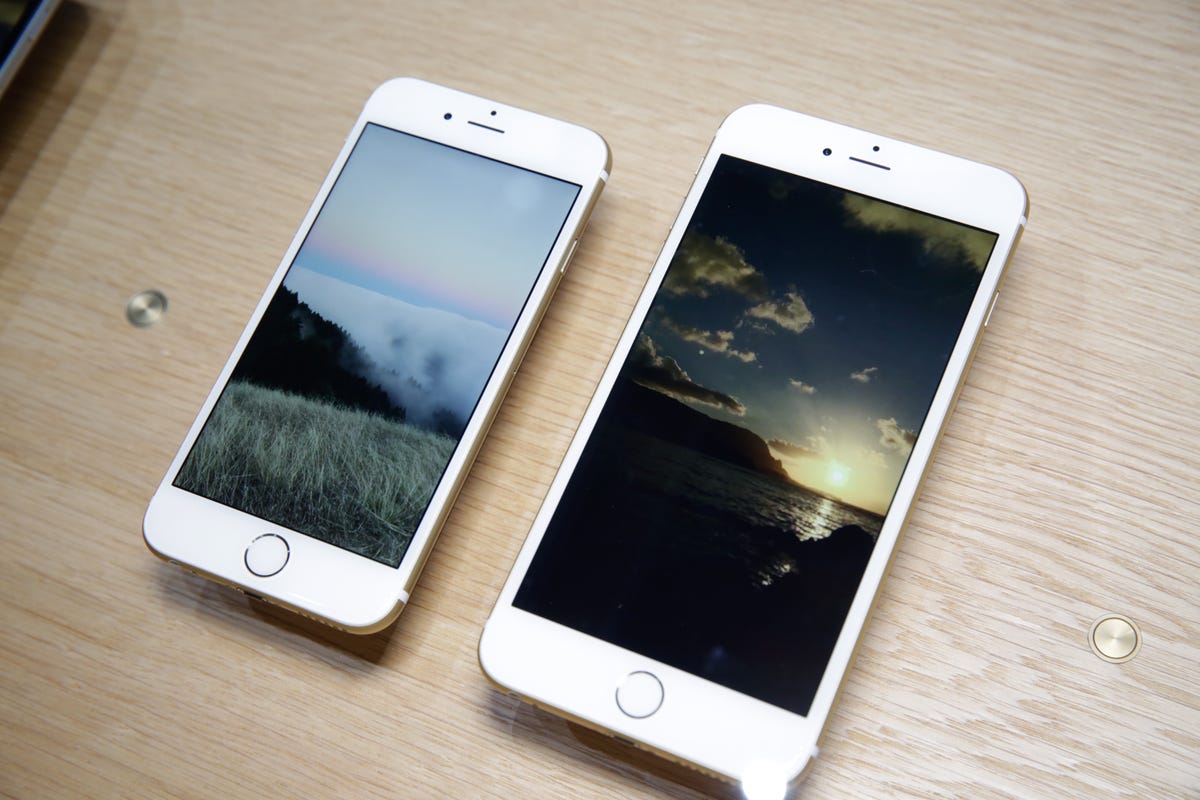
iPhone 6 and iPhone 6 Plus
Apple has unveiled the iPhone 6 and iPhone 6 Plus. The phones sport entirely new hardware running on Apple iOS 8 and will be available on September 19.
A bigger iPhone
The 4.7-inch display on the iPhone 6 is larger than the on the iPhone 5S, but it's still fairly small as smartphones go. The iPhone 6 Plus sidles up right along side phablets like the Samsung Galaxy Note 4.
iPhone 6 and iPhone 6 Plus
The larger display offers more pixels per inch than previous iPhones -- Apple is calling it Retina HD.
The 5.5-inch iPhone 6 Plus has a 1,920-by-1080-pixel resolution display, serving up 401 pixels per inch (PPI). The 4.7-inch iPhone 6 has a 1,334-by-750-pixel resolution display, and a PPI of 326. That's identical to the PPI of the iPhone 5S, which has a 1,136-by-640-pixel resolution display.
The thinnest iPhones yet
While decidedly larger, the iPhone 6 and iPhone 6 Plus are both thinner than any iPhone that's come before them. The iPhone 6 is 6.9mm thick, while the iPhone 6 Plus is 7.1mm thick -- the iPhone 5S, by contrast, is 7.6mm thick.
Might still fit in your pocket
Sure, they're larger. But the iPhone 6 and iPhone 6 Plus can still fit right into your pocket. Maybe.
New hardware
All new A8 and M8 processors promise to offer new functionality and faster performance. Apple claims that the A8 processor will offer 50 percent faster graphics, and a 25 percent faster CPU.
Barometer
The M8 co-processor we first saw in the last generation iPhone gets a few new sensors.
The new barometer sensor, for example, will track elevation -- Nike's working on an app that'll actually give you credit for all those flights of stairs you're traversing.
More LTE bands
There's also support for up to 20 LTE bands, which should make for more compatibility worldwide. In the US, the phones will be available on AT&T, Verizon, Sprint, and T-Mobile.
Voice over LTE
The iPhone 6 and iPhone 6 Plus will now support Voice over LTE, so you can have simultaneous voice and data on your iPhone.
Vainglory
One developer showed off a competitive mobile game that aims to offer "console-quality" graphics at a smooth 60 frames per second.
Battery life
But all of that extra performance shouldn't hamper battery life -- Apple promises that the iPhone 6 and iPhone 6 Plus will perform at least as well the iPhone 5S.
New iSight camera
Both phones sport brand new, revamped iSight cameras, which promise improved performance.
The 8-megapixel shooter packs an f/2.2 aperture lens, a backside-illuminated CMOS sensor with 1.5μm pixels, and Apple's True Tone flash. Apple claims that the new sensor will offer even faster autofocus.
Improved face detection
Apple claims that the upgraded A8 processor offers superior image processing, paving the way for things like better face detection.
The phone will also let you take massive, high-resolution panoramic images -- up to 43 megapixels.
Video gets a boost
The video recording capabilities have seen a bit of a bump, too. The iPhone 6 and iPhone 6 Plus will be able to record 1080p video at 30 or 60 frames per second. They'll also be able to shoot slo-mo video at 120 or 240 frames per second.
Improved FaceTime camera, too
The front-facing FaceTime HD camera has seen a bit of love too, with an all-new sensor and an f/2.2 aperture lens.
iPhone 6 pricing
Here are the prices for the iPhone 6. For US residents, the 16GB version is just $199, 64GB runs $299, and $399 bumps you up to 128GB. In the UK, it will run you £539, £619, and £699, respectively, while in Australia the line of iPhone 6s is priced at AU$869, AU$999, and AU$1,129.
iPhone 6 Plus pricing
The base iPhone 6 Plus comes at a $100 premium over its slightly-smaller sibling. The iPhone 6 Plus starts at $299 for 16GB, $399 for 64GB, and $499 for 128GB in the US, and £619, £699, and £789, respectively, in the UK. Australian pricing is AU$999 for 16GB, AU$1,129 for 64GB, and AU$1,249 for the top-of-the-line 128GB model.
Mobile payments, by Apple
And now for something entirely different: Apple Pay aims to replace the wallet entirely. It's a mobile payments system that'll allow you to tap your phone at the credit card terminals at participating merchants.
There's no need to reach for a credit card, as all of that data is stored in the Passbook app.
Apple promises secure payments
To add a credit card to your Apple account, just take a picture of it. Apple communicates with your bank to ensure that you're actually the rightful owner.
All transactions are then handled by one-time use digital security codes. Apple and the merchant you're shopping with don't get any of your personal details -- everything about the transaction is limited to your and your bank.
Touch ID
Apple's Touch ID will figure prominently in the Apple Pay process. You'll use your fingerprint to confirm your purchase at a retailer.
NFC support, at last.
Built in NFC -- paired with Touch ID -- powers the Apple Pay experience. Just tap your phone to a retailer's NFC reader and you're good to go.
Plenty of participating merchants
Apple Pay will only be as useful as the merchants who are participating -- fortunately for Apple, plenty of companies are getting on board. McDonald's will even let you use Apple Pay at the drive-thru.
Apple Pay will be available in October.

